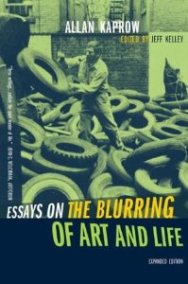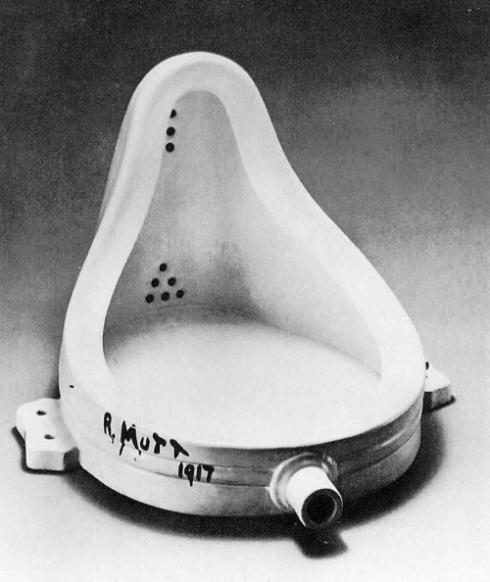Our reading for the week was the book Essay on the Blurring of Art and Life, a book of Allan Kaprow’s writings about his work edited by Jeff Kelley.
My original reflection on the reading…
I’ve had experience studying Kaprow before, in Performance Art and Performance Theory classes during my masters.
Kaprow’s signature contribution to art is the Happening.
Happenings are tough to define, partly because Kaprow’s own definition shifted over time. Basically, they’re a art performance or installation that happens outside the bounds of the traditional art sphere (i.e. galleries, theaters, etc.)
That’s really broad. Winnowing down, Kaprow was concerned with the question, “What is art?” His solution partly involved taking the elements of what makes art, consciously, art, and instead using everyday locations, objects, and actions to challenge the perception of art itself. Starting with more scripted events, Kaprow eventually got to a point where events only happened once, they weren’t promoted, and there was a chance the people participating in them weren’t even aware of their intentions, meanings, etc. To Kaprow, art was the actual creation and execution of art. Not necessarily the creations themselves or the spaces they’re contained in.
I’ve been a part of happenings before, typically of the more scripted variety where the audience was aware of their participation.
And what this reading does for me is raise the topic of the conscious versus the subconscious.
Once we’re conscious of something, we automatically assign culturally curated symbolism, meaning, and definition to it. As such, people in a gallery will behave the way people in a gallery are “supposed” to behave, and they’ll automatically register the gallery’s contents as “art”, because that’s what’s in a gallery.
By leaving the safe confines of the curated, controlled space, Kaprow was able to get a more honest, perhaps visceral reaction from his audience, which in a way, is art.
I remember taking a class on Dada and Surrealist art at the Nasher Sculpture Center. One time in class, I made the, tired, statement that art is subjective. My professor, a curator at the center, corrected me. She said, our reaction to art is subjective.
Such a small change in the statement makes a big difference. It acknowledges that something is art if we call it art, taking the power away from the art academy and placing it squarely on the spectator. And there’s something to that. Think of things we interact with everyday. A chair, a table, a toilet (Hello, Duchamp!). All of these things had to be designed. They are, in their own way, art. But, because they exist in our everyday lives, and perhaps because they serve very practical purposes, we don’t immediately identify them as being artistic. The Dadas and Surrealists plead their own part in challenging these notions. Duchamp’s readymades specifically did this. Especially his work Fountain, a urinal turned on its back and signed, as a work of art would be.
Collage and some of the Dada sculpture would also fall into this category.
But, Kaprow took that a step further. After all, a lot of these Dada and Surrealist works were still displayed in galleries and exhibitions where they were defined as art. Kaprow took his art outside of the gallery, noting in the book that in order to get to the heart of what is art, you had to un-art the art, or basically strip it of the signifiers that identified it as art. So, take it out of the gallery, don’t sign it, don’t advertise it as art. Just let it happen, as it were.
This, in turn, will elicit a spontaneous, unconscious reaction from the audience, which can then reveal the true definition and nature of art.
I totally dig what Kaprow is saying, to an extent. We live in a socially constructed world and follow script throughout our everyday lives. So, when someone walks into a theater or a gallery, they’re playing the role of audience member, art patron, etc. Due to these roles that we take on, we behave in certain ways, and look at the contents in a certain way. We perceive the art as art simply because we’re in a place that houses art. Not necessarily because it actually is art. Confused yet?
I like the idea of getting your audience into an unconscious space. Getting them to react spontaneously and authentically to art really is, perhaps, one of the most interesting aspects of art.
However, what the Dadas and Surrealists played a big role in starting, and what Kaprow furthered, is this postmodern notion of deconstruction. And while there is a way in which deconstruction can be a very good thing, what happens at the end when we’ve torn the entire academy down?
By deconstructing the notion of “What is art?”, we tear it down to its parts to such an extent that we invite a total relativistic outlook on the form as a whole that in the search for meaning can dilute it to the point that it has no meaning.
As Hakim Bey suggested in TAZ: Go into the lobby of a Citibank, drop your pants, take a shit on the floor, and walk out.
Sure, you can identify that as an artistic expression. Especially in today’s world where there is such distrust of the large banks. But, if no one else knows about it, is it art? Is it enough that the 20 people in the bank perceived the action and questioned in their own heads what it meant?
I agree that we should find ways to break down the social scripts that can, arguably, sometimes limit art. But, how far can we break them down before there is no script left? Are we truly living in an age that’s so subjective that it’s enough if just one person unconsciously perceives it as art?
And think of it on a practical level. It’s fine when you’re the one leading the charge on these movements, but what happens to artists who come after? I feel it’s safe to say that the world needs art and artists. But, we let those who came before us tear down the academy to a point that we’ve entered into a time of cynicism where everything is considered trite or derivative. Everything is been there, done that.
Kaprow was great, but he got to work in a time when the art world was still somewhat strong, so his abstraction meant something. But, his development of the Happening, in a way, can play as him pulling the pin on a grenade on his way out the door and making it more difficult for everyone who comes after him. The grand narrative (or meta narrative) of art has been broken down to a point that to participate in the traditional art world these days is considered tired. As Tom Riccio said to me during a meeting, “Theater is dead.” (For this example, consider that theater can mean art in general). Now, Tom didn’t mean that theater itself is dead. That’s obviously not true. Broadway posted record ticket sales last year. What he meant is the “box” is dead. The traditional theater, with its proscenium seating and coherent, self-contained narratives, is dead. To participate in this old form is to be living in the past, to an extent.
I, in all my amateurism, disagree. I think it’s still possible to work within the box (whether that be a theater, a gallery, or whatever else) and create great, progressive art. The key, as Kaprow’s work gets at, is getting the audience to truly unconsciously react to the art within. How to do that? I’m not totally sure. But, I’ll keep working on it.
I know going into this class, that Tom is a fan of site specific artistic work. His group, Dead White Zombies specializes in site specific performance. And, I think it’s really cool and results in really visceral, honest performances. I like the notion. And it’s something I want to do with my work. Which leads me to the assignment (etude) for the week…


